The LG G5 Review
by Matt Humrick on May 26, 2016 8:00 AM EST- Posted in
- Smartphones
- Snapdragon
- Qualcomm
- LG
- Mobile
- Snapdragon 820
- LG G5
GPU Performance
The LG G5 uses Qualcomm’s latest Adreno 530 GPU. We officially know next to nothing about its low-level architecture; Qualcomm remains tight-lipped about its GPUs, turning them into intriguing black boxes. From the few shreds of information the company has shared over the years, along with our detailed measurements, we know that improving ALU performance has been a top priority for the past few generations. This emphasis has given Adreno GPUs an advantage in games that make heavy use of pixel shading and post-processing, but ARM’s Mali and Imagination’s PowerVR GPUs still held an edge in vertex processing in some configurations. Our initial look at the Adreno 530 showed that it’s a more balanced architecture, with big improvements to vertex processing that alleviate the biggest handicap for past Adreno GPUs.
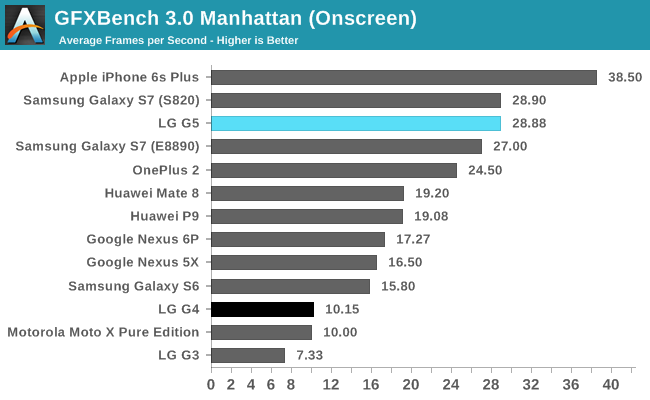
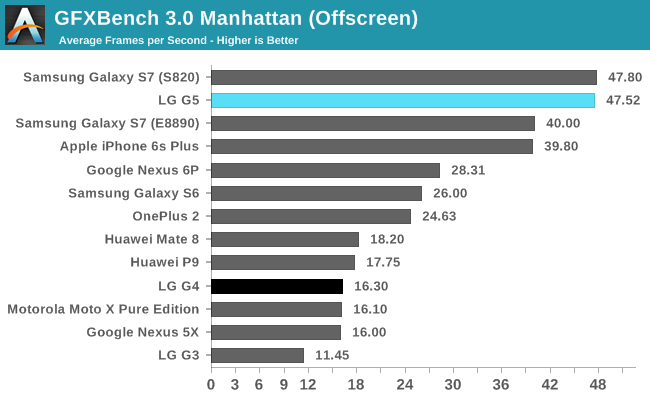
GFXBench 3.0 uses an OpenGL ES 3.0 game engine that stresses lighting and pixel effects. In the offscreen results, Qualcomm’s Adreno 530 leads the pack. The G5 outperforms the previous generation Adreno 430 in the Nexus 6P by 68% and is almost three times faster than the Adreno 418 in the G4.
Even when rendering onscreen at 1440p, the Adreno 530 in the G5 and Galaxy S7 outpace the OnePlus 2’s Adreno 430 rendering at a lower 1080p resolution. The G5 also maintains its nearly 3x advantage over the G4, a significant jump for just one generation.
In the previous section, we routinely saw Huawei’s Mate 8 and P9 near the top of our performance charts; however, their GPU performance is not at the same level. While both use ARM’s latest Mali-T880 GPU, they employ fewer cores (four) that ramp to a high max frequency. The Exynos 7420 SoC in Samsung’s Galaxy S6 uses the previous generation Mali-T760 GPU in an eight core configuration with a slightly lower max clock. With more ALUs and twice as many texture units, the Exynos 7420 offers better GPU performance than the Kirin 950 and 955 in Huawei’s flagships.
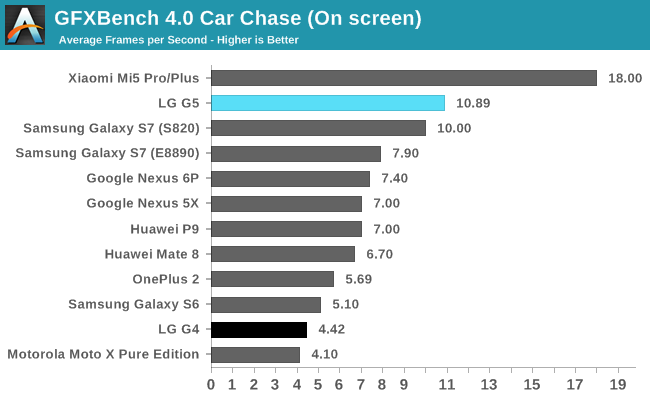
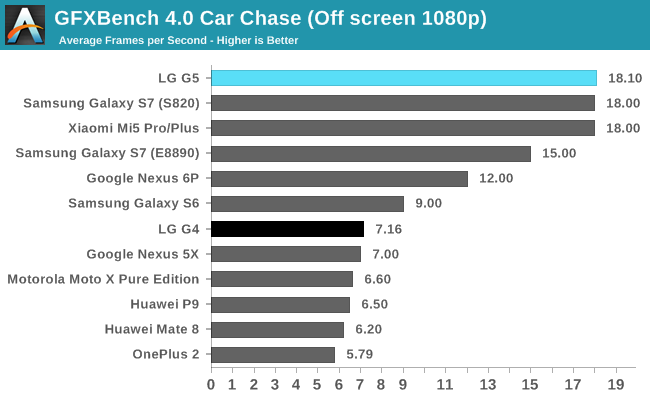
GFXBench 4.0 Car Chase is Kishonti’s latest high-level game engine that uses OpenGL ES 3.1 with Android Extension Pack. Like the earlier Manhattan test, it uses deferred rendering and dynamic lighting, but it also adds visual effects such as HDR tone mapping, motion blur, and bloom using geometry and compute shaders. Perhaps the biggest change is the inclusion of hardware tessellation.
With its heavy reliance on compute shaders, it’s not surprising to see the Adreno 530 GPUs out front once again in this test. The Mali-T880MP12 GPU in the Galaxy S7’s Exynos 8890 SoC comes within 20% of the G5’s Adreno 530, but this margin increases to 38% when running onscreen. The Nexus 6P’s newer graphics driver helps boost performance over the OnePlus 2 by about a factor of two.
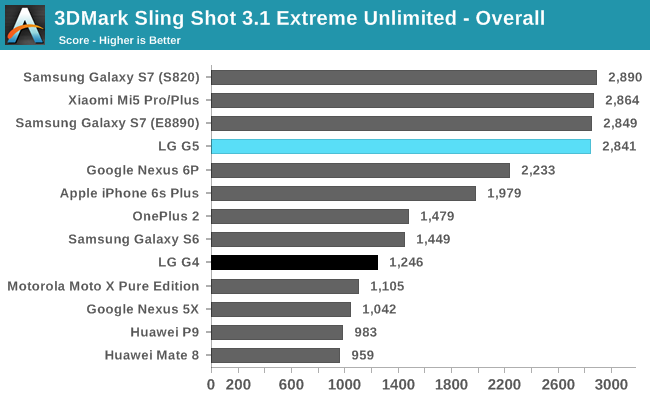
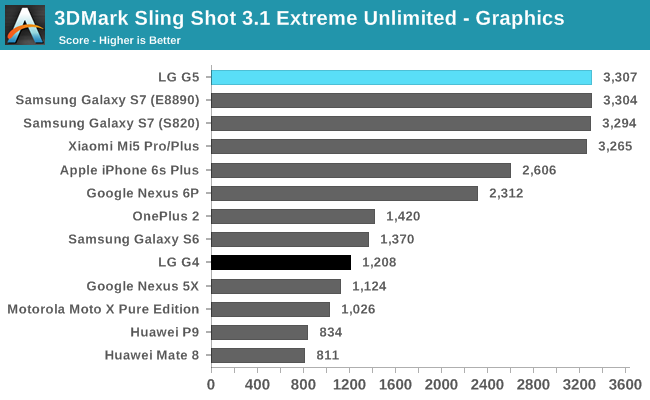
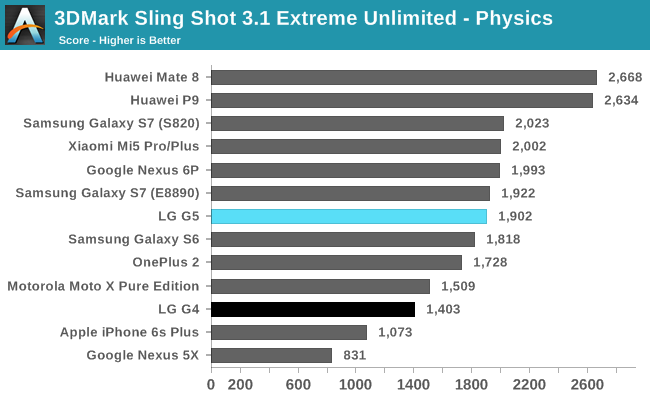
We recently moved from 3DMark’s Ice Storm Unlimited, which uses an OpenGL ES 2.0 graphics engine and renders offscreen at 1280x720, to 3DMark’s newer Sling Shot 3.1 Unlimited, which uses either OpenGL ES 3.1 on Android or Metal on iOS and renders offscreen at a 2560x1440 QHD resolution.
Once again the G5 does well overall thanks to its strong performance in the graphics tests. It’s interesting to see the Exynos 8890 version of the Galaxy S7 perform exactly the same as the Snapdragon 820 phones in the graphics test after trailing in GFXBench 4.0 Car Chase.
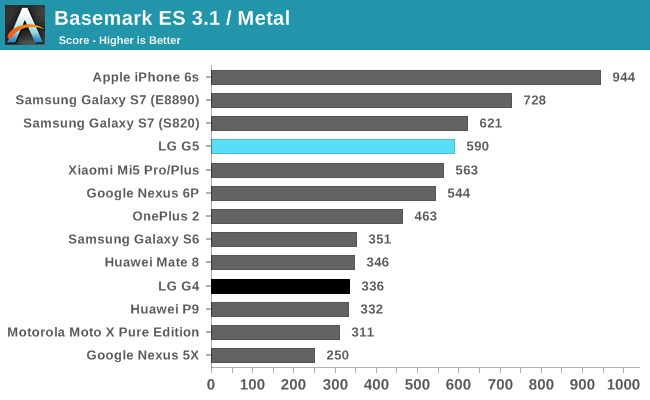

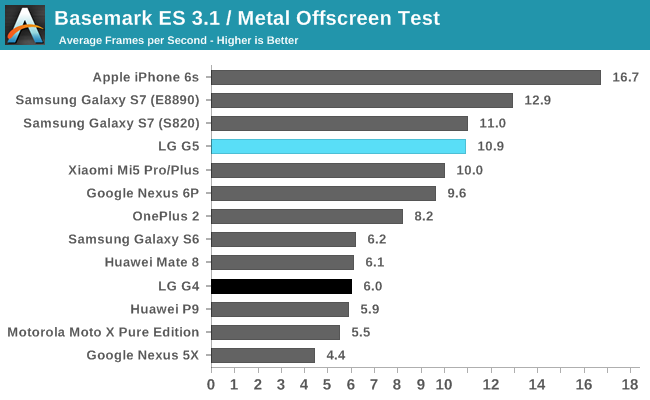
Basemark ES 3.1 is another test that uses either OpenGL ES 3.1 on Android or Metal on iOS. It’s rendering pipeline and feature set are similar to GFXBench 4.0 Car Chase, but it omits tessellation. There’s both on onscreen and offscreen test, with the offscreen test rendering at 1080p.
Here we see the Galaxy S7 and its Exynos 8890 SoC jump ahead of the G5 and the other Snapdragon 820 phones for the first time. Because this is such a complex test with so many graphical features enabled, we cannot gain any insight into particular strengths and weaknesses of each GPU architecture.
Based on these tests it’s clear the G5 offers a significant increase in peak GPU and gaming performance over the G4. It’s Adreno 530 GPU is two to three times faster than the G4’s Adreno 418 and about 50% faster than the Nexus 6P’s Adreno 430 in most tests. The G5 performs better than the Exynos 8890 version of the Galaxy S7 in the two GFXBench tests, but falls a little behind in Basemark ES 3.1. Neither the G3 nor the G4 could match the peak gaming performance of flagship phones in their day, but the G5 is the first in LG’s G Series to get a GPU powerful enough to drive its QHD display. Peak performance is great for benchmarks and bragging rights, but sustained performance, which we’ll examine in the next section, is the real metric that affects the overall gaming experience.










92 Comments
View All Comments
tuxRoller - Thursday, May 26, 2016 - link
Ok, what the hell is Xiaomi putting in their phones?Are there hidden racing stripes?
It's gotta be.
tipoo - Friday, May 27, 2016 - link
They're using one (well, two) of the first shipping Cortex A72 designs. However, they give up some GPU performance with their Mali for that impressive CPU.tuxRoller - Friday, May 27, 2016 - link
http://www.gsmarena.com/xiaomi_mi_5_plus-7260.phpApparently it uses a sd820.
tipoo - Saturday, May 28, 2016 - link
Doh, I crossed my Huawei and Xiaomi wires, thought you meant the Mate 8 and P9.lucam - Thursday, May 26, 2016 - link
Hi Matt, you should have added also the GFX Bench 1440p Manhattan in your bench.Matt Humrick - Friday, May 27, 2016 - link
We did include GFXBench 3.0 Manhattan onscreen results. Also, our battery test uses GFXBench Manhattan 3.1 onscreen, so you can see the G5's peak score at the beginning and how its performance drops over time.lucam - Friday, May 27, 2016 - link
The GFXBench 3.0 onscreen is not the new one 3.1 1440p. But I guess it so new that you couldn't test on new devices.Klug4Pres - Friday, May 27, 2016 - link
I wish these reviews would specify the software being run on the different phones that are compared in the benchmarks. For example, with the LG G3, is it running Marshmallow, Lollipop or KitKat? What benchmark version?I would have thought that unless you keep phones and upgrade and retest them on newer software versions, you are going to see big performance differences that may not reflect underlying differences in SoC perf.
Matt Humrick - Friday, May 27, 2016 - link
You bring up a very good point. I too would like to see us provide more info regarding software/benchmark version numbers and will discuss it with the team.As for the G3, it was running Android 5.0.1 with all carrier (Sprint) and Google updates applied.
Lolimaster - Friday, May 27, 2016 - link
Can you put a big FAILZODIA on top of the review.3 times that LG keeps failing hard in the most important regard, screeen quality. Everything done right design wise gets completely destroyed by their pathetic choice in regards to screen quality,
98% DCI-P3 and no proper sRGB options? HELLO? Pretty much everything is sRGB, android is a mess for wide gamut options, why even try?
The only way of delivering this piss poor calibrated screens is by doing it on purpose. It's not even acceptable for a low end smartphone.